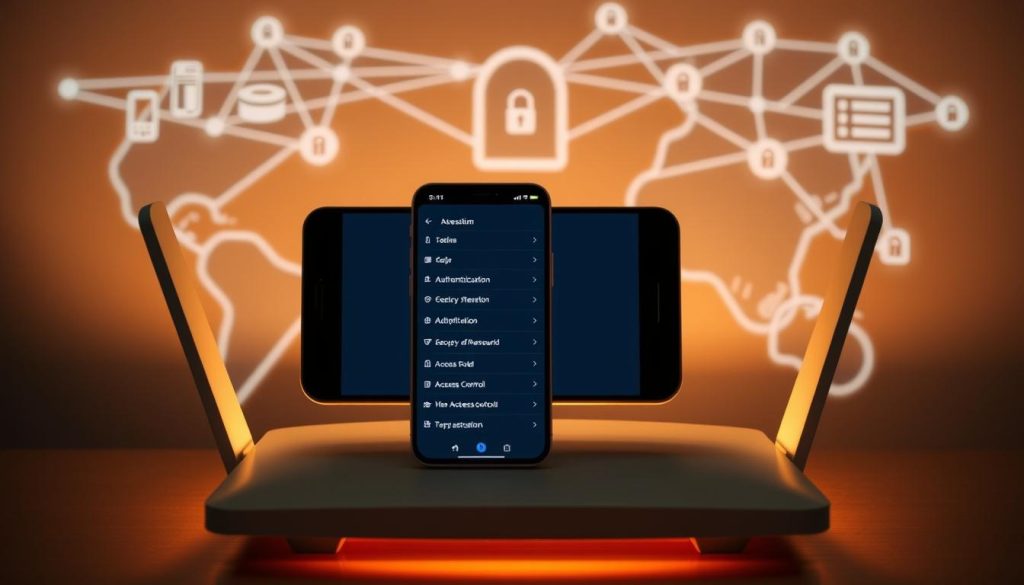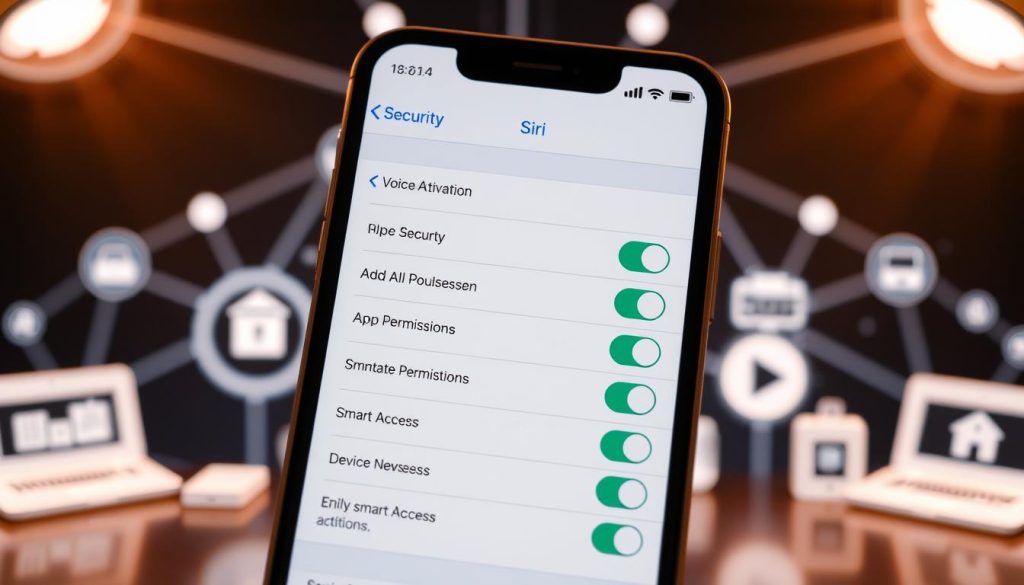You use voice assistants like Amazon Alexa, Google Assistant, and Apple Siri to make life easier. But, as they get more popular, big privacy concerns come up.
When you add these devices to your home and work, it’s important to think about security risks. Knowing what these devices can be vulnerable to helps keep your personal info safe.
With the right security steps, you can still enjoy the benefits of voice assistants while keeping your data secure.
Key Takeaways
- Understand the potential security risks associated with voice assistants.
- Implement effective security measures to protect your personal data.
- Learn best practices for securing popular voice assistants.
- Discover how to safeguard your information while using voice assistants.
- Stay informed about the latest security concerns related to voice assistants.
The Rising Security Concerns with Voice Assistants
Voice assistants are now common in many homes, raising security concerns. You might use Amazon Alexa, Google Assistant, or Apple Siri for tasks like setting reminders or controlling smart home devices.
How Voice Assistants Have Become Household Staples
Voice assistants have changed how we use technology. Convenience and ease of use have made them very popular. Now, you can control your smart home, play music, and get information easily.
Common Security Vulnerabilities in Smart Speakers
Smart speakers are convenient but come with risks. Risks include unauthorized access and data breaches. It’s important to know these risks to keep your devices safe.
Regularly update your device’s software and be careful with third-party skills. This can help reduce these risks.
Understanding these vulnerabilities is key to keeping your smart speakers secure. By being proactive, you can protect your personal data and keep your smart home safe.
Understanding How Voice Assistants Work
To understand the security concerns of voice assistants, we need to know how they work. They use advanced technologies to understand and act on voice commands.
Voice Recognition Technology Explained
Voice recognition is key for voice assistants. It lets devices understand spoken words. Advanced voice recognition systems get better over time, thanks to learning from users.
Data Processing and Storage Methods
After recognizing a voice command, the data is processed and stored. Voice assistants use cloud-based processing to analyze this data. This means sending the audio to remote servers. The data is then kept in secure places for later use.
| Data Processing Method | Description | Security Implication |
|---|---|---|
| Cloud-based Processing | Data is transmitted to remote servers for analysis. | Potential for data breaches during transmission. |
| Local Processing | Some data is processed directly on the device. | Reduced risk of data exposure. |
| Hybrid Approach | Combination of local and cloud-based processing. | Balances efficiency and security. |
Cloud Connectivity and Its Implications
Cloud connectivity is essential for voice assistants. It lets them access lots of resources and learn from users. But, it also raises security concerns like unauthorized access to stored data and eavesdropping. It’s important to understand these risks to keep our data safe.
Potential Security Threats to Voice Assistants
Using voice assistants in your daily life comes with security risks. These devices, like any connected device, can face various threats. These threats can harm your personal data and privacy.
Unauthorized Access Risks
There are several ways unauthorized access can happen. This includes voice impersonation attacks and physical access vulnerabilities.
Voice Impersonation Attacks
An attacker can mimic your voice to get into your voice assistant. They might use advanced speech synthesis or record and play back your voice.
Physical Access Vulnerabilities
If someone gets physical access to your device, they could get into your voice assistant. Make sure your devices are locked with strong passwords or biometric authentication.
Data Privacy Concerns
Voice assistants collect a lot of personal data. This raises big privacy concerns. You should know how your data is used and stored.
Potential for Eavesdropping
Eavesdropping is a big threat to voice assistants. Attackers might listen in on your conversations or get to sensitive information. This is because of vulnerabilities in the system.
| Security Threat | Description | Mitigation |
|---|---|---|
| Unauthorized Access | Access to voice assistant without permission | Use strong passwords, biometric authentication |
| Data Privacy Concerns | Misuse of personal data collected by voice assistants | Review data collection policies, limit data sharing |
| Eavesdropping | Unauthorized listening to conversations | Use secure networks, update software regularly |
Setting Up Voice Assistants with Security in Mind
To keep your voice assistant safe, you must set up your network right and choose the best privacy settings. This means taking a few important steps. These steps will make your device more secure and keep your data safe.
Secure Network Configuration Steps
Setting up your network securely is key to fighting off threats. You should make a strong Wi-Fi password and turn on network encryption.
Creating Strong Wi-Fi Passwords
A strong Wi-Fi password keeps your network safe from unwanted access. Here’s how to make a strong password:
- Use a mix of uppercase and lowercase letters.
- Add numbers and special characters.
- Don’t use easy-to-guess info like your name or birthdate.
Enabling Network Encryption
Turning on network encryption, like WPA3, makes your network data safe. To do this:
- Go to your router’s settings.
- Find the wireless settings section.
- Pick WPA3 as your encryption if it’s available.

Initial Privacy Settings to Enable
Turning on privacy settings on your voice assistant helps keep your data safe. Some important settings to turn on include:
- Voice recognition to make sure only allowed users can use your device.
- Data deletion options to clear your voice history regularly.
- Guest mode or multi-user settings to control who can talk to your voice assistant.
By doing these steps, you can greatly improve your voice assistant’s security. This will also protect your personal data.
Securing Voice Assistants: Alexa, Google Assistant & Siri Best Practices
Voice assistants are now a big part of our lives. It’s important to keep them safe. We need to follow some key steps for all voice assistants.
Universal Security Measures for All Platforms
There are some steps you should take for all voice assistants. These steps help keep your voice data safe.
Regular Voice History Deletion
Deleting your voice history often is a must. It helps protect your privacy. This way, your voice data is less likely to be used without your permission.
Muting Microphones When Not in Use
It’s also key to mute your microphone when not using your voice assistant. This stops unwanted recordings from happening.
Platform-Specific Security Considerations
While general steps are good, each voice assistant has its own special features. Knowing these can help you make your security even better.
For example, learning about the privacy settings of Alexa, Google Assistant, and Siri can help you secure each one better. This makes your voice assistants safer.
| Platform | Key Security Feature | Action Required |
|---|---|---|
| Alexa | Voice Purchasing Settings | Manage settings to prevent unauthorized purchases |
| Google Assistant | Voice Match Configuration | Configure Voice Match to enhance security |
| Siri | Siri & Dictation Privacy Settings | Review and adjust privacy settings for Siri and Dictation |
By following both general and specific steps, you can make your voice assistants much safer.
Alexa-Specific Security Measures
Securing your Alexa device is easy and important for your privacy. You can do this by adjusting settings and knowing about potential risks. This way, you keep your device safe and your privacy intact.
Managing Voice Purchasing Settings
To protect your Alexa, start with voice purchasing settings. You can set a voice code for buying things or turn off voice buying to stop unauthorized purchases.
Setting Up Voice Codes for Purchases
To set up a voice code, follow these steps:
- Open the Alexa app on your device.
- Go to Settings and select “Voice Purchasing.”
- Enable “Voice Code” and follow the prompts to set up a four-digit code.
Disabling Voice Purchases Entirely
If you don’t want to buy things with Alexa, you can turn off voice buying:
- Open the Alexa app.
- Navigate to Settings > Voice Purchasing.
- Toggle off “Voice Purchasing” to disable this feature.
Setting Up Voice Recognition
Alexa’s voice recognition can make your device more secure and personal. By enabling voice match, Alexa will only respond to your voice.
To set up voice match, go to the Alexa app, then Settings. Follow the instructions under “Voice Match.” This ensures only your voice can activate Alexa.

Reviewing and Deleting Voice History
It’s important to regularly check and delete your voice history. Alexa records your voice, and managing this data keeps your device secure.
Step-by-Step Voice History Deletion
To delete your voice history, follow these steps:
- Open the Alexa app.
- Go to Settings > Alexa Privacy > Manage Voice History.
- Select the recordings you want to delete or choose to delete all recordings.
Scheduling Automatic Deletions
You can also set up automatic deletions of your voice history:
- In the Alexa app, go to Settings > Alexa Privacy.
- Select “Manage Voice History” and then “Auto-delete.”
- Choose the deletion frequency that suits your privacy needs.
By following these steps, you can greatly improve your Alexa’s privacy and security.
Google Assistant Security Best Practices
To keep your Google Assistant safe, it’s important to know and use several key features. Google Assistant is designed to be helpful and easy to use. But, it needs some security settings to protect your privacy and safety.
Voice Match Configuration Steps
Setting up Voice Match is a key step in securing your Google Assistant. Voice Match lets your Assistant know it’s you talking. To set it up, go to your Google Assistant settings, choose “Voice Match,” and follow the steps to teach your Assistant your voice.
Managing Activity Controls
It’s crucial to manage Activity Controls to control what data your Google Assistant collects and keeps. This includes managing your Web & App Activity and Audio Recording Controls.
Web & App Activity Settings
To manage your Web & App Activity, go to your Google Account settings. Then, go to “Data & personalization,” and pick “Web & App Activity.” Here, you can decide if your Assistant keeps your interactions.
Audio Recording Controls
For Audio Recording Controls, you can choose if your voice recordings are kept or deleted automatically. You can do this in the “Data & personalization” section of your Google Account settings.
Guest Mode and Multiple User Settings
Guest Mode is great because it lets others use your Google Assistant without seeing your personal info. To turn on Guest Mode, say “Hey Google, turn on Guest Mode” or change the setting in your Assistant’s settings. You can also set up Multiple User Settings to let your Assistant know when different people are talking. This way, everyone gets a personalized experience.
Securing Apple’s Siri on Your Devices
To keep your personal data safe, it’s key to know how to secure Siri on your Apple devices. Siri makes using your device easier, but it also has security risks if not managed right.
Siri & Dictation Privacy Settings
Changing Siri and dictation privacy settings is a big step in keeping Siri safe. It’s about controlling how Siri recordings are handled and keeping your Siri talks private.
Managing Siri Recording History
You can manage your Siri recording history by going to your Siri settings. Just go to Settings > Siri & Search, then tap on Siri & Dictation History. Here, you can delete your Siri history, which removes your voice recordings from Apple’s servers.
Controlling App Access to Siri
It’s also important to control which apps can use Siri. Go to Settings > Siri & Search and turn off any apps you don’t want to use with Siri. This stops unauthorized apps from using Siri and possibly doing harm.
Lock Screen Access Restrictions
Limiting Siri access from the lock screen is crucial to keep your device safe. To do this, go to Settings > Siri & Search and turn off Allow Siri When Locked. This makes Siri only available when your device is unlocked, adding more security.
Managing Siri Data in iCloud
It’s also important to manage Siri data in iCloud. Go to Settings > [your name] > iCloud > Manage Storage to review and manage your Siri data. Here, you can see what data is stored and manage or delete it as needed.

Protecting Children’s Privacy with Voice Assistants
Voice assistants are everywhere, making it key for parents to protect their kids’ privacy. As these devices get more common in homes, the chance of kids’ personal info being shared grows.
Parental Controls for Each Platform
Parents can use parental controls on voice assistants to lower these risks. This means setting up specific controls for each platform.
Amazon Kids+ Settings
Amazon Kids+ lets parents block mature content and control voice buys. It makes Alexa safer for kids.
Google Family Link Configuration
Google Family Link lets parents watch and manage their child’s Google Assistant use. It sets limits on what they can see and do.
Apple Screen Time for Siri
Apple Screen Time helps parents limit Siri use and track how much time kids spend with it. It gives parents control over Siri interactions.
Kid-Friendly Security Settings
Setting up kid-friendly security is also vital. This includes making sure voice recognition works right and that the device doesn’t collect too much data.
| Platform | Parental Control Feature | Key Functionality |
|---|---|---|
| Amazon Alexa | Amazon Kids+ | Limits mature content, manages voice purchasing |
| Google Assistant | Google Family Link | Monitors and controls activity, sets limits |
| Apple Siri | Apple Screen Time | Restricts Siri access, monitors usage |
By using parental controls and setting up secure settings, parents can greatly improve their kids’ privacy with voice assistants.
Securing Third-Party Skills and Actions
To keep your voice assistant safe, it’s important to check third-party apps and their permissions. These apps can make your voice assistant better, but they can also be risky if not managed right.
Vetting Third-Party Applications
When you add third-party skills or actions, know what you’re allowing. Always check the developer’s privacy policy and terms of service. Choose apps from trusted companies with a good security record.
- Check the skill or action’s reviews and ratings.
- Understand what data the skill or action can access.
- Be cautious of skills or actions that request excessive permissions.
Permission Management for Skills/Actions
Managing permissions is crucial for your voice assistant’s security. Each platform has its own way to handle permissions.
Reviewing Skill Permissions on Alexa
To see permissions on Alexa, open the Alexa app. Go to Settings, then Skills & Games, and pick the skill you want to check. Here, you can see what permissions it has and turn off any you don’t need.
Managing Google Action Permissions
For Google Assistant, open the Google Assistant app. Go to Settings, then Actions & notifications, and look at the permissions for each action. You can adjust these permissions to fit your comfort level.
Removing Unused or Suspicious Skills
Check your voice assistant’s skills and actions often. Remove any you don’t use or seem fishy. This makes your voice assistant safer.
- Find unused skills or actions.
- Turn them off or delete them through your voice assistant’s app.
- Watch for any odd behavior from your voice assistant.

Regular Security Maintenance for Voice Assistants
To keep your voice assistant safe, regular maintenance is key. Voice assistants like Alexa, Google Assistant, and Siri are now a big part of our lives. So, it’s important to check their security often to avoid threats.
Creating a Security Audit Schedule
Having a security audit schedule is essential. It keeps your voice assistant safe. Regular checks can spot problems before they cause trouble.
Monthly Security Check Steps
- Review device activity logs for suspicious activity.
- Check for unauthorized skills or actions.
- Verify that all connected devices are authorized.
Quarterly Deep Dive Review
- Analyze voice recognition settings and update as necessary.
- Review and delete voice history.
- Check for firmware and software updates.
Firmware and Software Update Best Practices
It’s vital to keep your voice assistant’s firmware and software current. Updates often fix known security issues.
Enable automatic updates whenever you can. This way, you’ll get the latest security fixes without delay.
Advanced Voice Assistant Security Techniques
To keep your voice assistants safe, think about using VPNs and network segmentation. As voice assistants play a bigger role in our lives, protecting them and their networks is key.
Network Segmentation for Smart Devices
Network segmentation is a top security method. It divides your network into smaller, safer parts. This helps stop malware and unauthorized access to your voice assistants.
Setting Up a Dedicated IoT Network
Setting up a special IoT network for your smart devices is smart. You can do this by setting up a separate network for your IoT devices on your router.
Configuring Router Security Features
It’s important to set up your router’s security features. This includes creating a guest network, using WPA3 encryption, and updating your router’s firmware often.
| Security Feature | Description | Benefit |
|---|---|---|
| Dedicated IoT Network | A separate network for IoT devices | Isolates smart devices from main network |
| WPA3 Encryption | Advanced encryption protocol | Protects data transmitted over the network |
| Regular Firmware Updates | Keeping router software up-to-date | Fixes security vulnerabilities and improves performance |
Using VPNs with Voice Assistants
Using a VPN with your voice assistants adds extra security. It encrypts data sent between devices and the internet. This is especially useful on public Wi-Fi.
Key benefits of using VPNs with voice assistants include:
- Encryption of data transmitted between devices and the internet
- Protection against eavesdropping and data theft
- Enhanced security when using public Wi-Fi networks
Recognizing and Responding to Security Breaches
Voice assistants like Alexa, Google Assistant, and Siri are now common targets for hackers. It’s vital to know the signs of a breach to protect your device and data. Being alert can help you act fast to keep your information safe.
Signs Your Voice Assistant May Be Compromised
Spotting a security breach early can prevent big problems. There are clear signs that your voice assistant might be at risk.
Unusual Activity Indicators
Listen for strange voice commands or actions you didn’t ask for. This could mean changes in settings or odd sounds from your device.
Unexpected Behavior Patterns
If your voice assistant acts strangely, like turning on lights or playing music without asking, it might be hacked.
Immediate Steps to Take After a Breach
If you think your voice assistant has been hacked, act quickly.
Factory Reset Procedure
Resetting your device to factory settings can remove malware. Check your user manual or the manufacturer’s website for how to do this.
Account Security Measures
Update your passwords and check your account settings to stop hackers. Use two-factor authentication if you can.
| Action | Description | Benefit |
|---|---|---|
| Factory Reset | Restores device to original settings | Removes potential malware |
| Change Passwords | Updates account passwords | Prevents unauthorized access |
| Enable Two-Factor Authentication | Adds an extra layer of security | Enhances account security |
Knowing the signs of a breach and how to react can protect your voice assistant and data. Always check your device’s security settings and be careful with third-party skills to stay safe.
Balancing Convenience and Security
Using voice assistants brings a balance between ease and safety. Tools like Alexa, Google Assistant, and Siri make life easier. They let you control your smart home and find information quickly. But, they also pose security risks that must be managed.
Determining Your Personal Security Threshold
First, figure out your security comfort level. Know what data you’re okay sharing with your voice assistant. Think about what features matter most to you and their potential risks. This helps you use your voice assistant safely and effectively.
Feature Trade-offs for Enhanced Security
Improving security might mean giving up some features. For example, turning off voice purchasing or limiting data storage can be safer but less convenient. Weigh these choices based on your security needs. This way, you can enjoy your voice assistant’s benefits while keeping your data safe.
Future of Voice Assistant Security
The security of voice assistants is changing fast. This is thanks to new tech and rules. If you use Alexa, Google Assistant, or Siri, it’s key to know how their security is improving.
Emerging Security Technologies
New tech is coming to keep voice assistants safe. Some of these include:
- Advanced Voice Recognition: Better voice recognition to tell users from intruders.
- AI-Powered Threat Detection: AI to spot and fight threats right away.
- Encryption Technologies: New encryption to keep data safe.
These new techs are key to making voice assistants more secure. They help protect your data.
Anticipated Regulatory Changes
New rules are coming to make voice assistants safer and more private. Some changes include:
- Stricter Data Protection Laws: Laws for better data protection.
- Enhanced Transparency Requirements: Clearer rules on data use and protection.
- Security Standards for Third-Party Skills: Rules for third-party developers to keep voice assistants safe.
Keeping up with these changes is important. It helps keep your voice assistants secure.
Conclusion
You now know how vital it is to protect your voice assistants, like Alexa, Google Assistant, and Siri. To keep them safe, you need a solid plan. This includes knowing the risks, setting up devices right, and keeping up with new threats and tech.
By using the tips from this article, you can make your voice assistants much safer. This means setting up devices with security in mind, managing third-party skills, and doing regular security checks.
As voice assistants get better, it’s key to stay updated on security and new tech. This helps you keep your devices safe and secure.
By being proactive and thorough in securing your voice assistants, you can enjoy their benefits while avoiding risks. This wraps up our guide on keeping voice assistants safe, giving you the knowledge and tools to do so.

